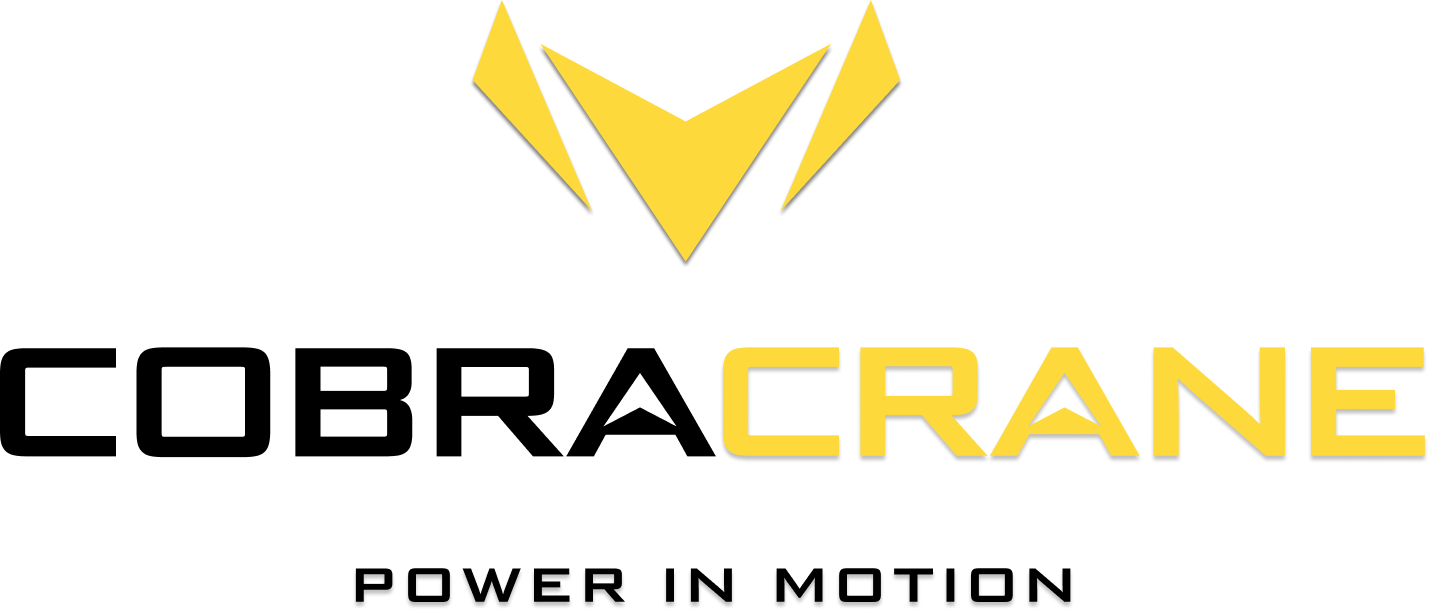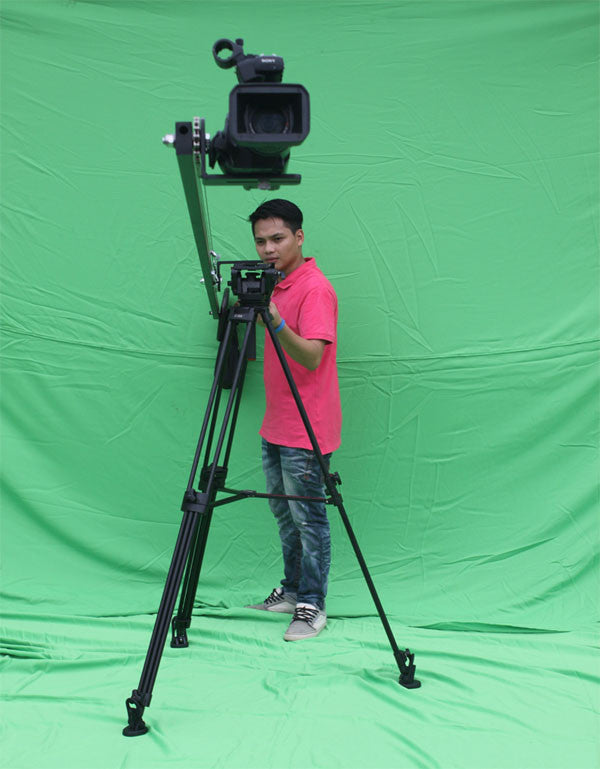How to operate the CobraCrane and CobraCrane BackPacker Camera Jib
There are three basic moves of a camera crane when shooting video. These moves done in combination will meet virtually any shooting requirement. The moves are Boom, Swing and Tilt.

A boom is when you change the elevation of the camera. This is done to offer shots that show vertical up and down movement. A swing, which happens when you move the crane left to right or right to left, is done to show a panoramic landscape or following talent as they move by the camera. Finally a tilt is done to tilt the camera relative to the boom. This allows for shots where you look down on something or look up at something, like a dogs point of view.

On CobraCranes equipped with the cable operated Panning kit, you can use the remote handle to independently pan the camera 90 degrees left and 90 degrees right at the end of the boom.
Booming
| To boom the crane, stand behind or to the side and simply lift the weight bar to lower the camera. Lower the weight bar to increase the height of the camera. Simple as that! | |
|
Tilt Locked If your tripod’s tilt is locked or you hold the tilt handle stationary while booming, the camera will remain framed on the subject depending on how far away from the focal point the camera is. Notice the houses in the background. The further away the subject is, the more likely they will remain in frame. |
|
|
Tilt Loose To keep you subject completely in frame, loosen the tilt lock to your taste (very little drag for me) and hold the tilt handle, making minor adjustments as you are booming the crane. This move will allow you to show talent from various height perspectives. |
|
|
Tilt Loose To eliminate tilting altogether, Loosen the tilt lock, eliminating drag. Move the tripod handle and the boom together. |
Some Boom moves to practice.
|
Boom from high to low Talent in Frame |
Station the crane so that the camera is in a high position. Slowly raise the weight bar with the tilt on the head locked. This will allow you to keep the talent in frame. |
|
Boom from low to high Talent in Frame |
Station the crane so that the camera is in a low position. Slowly lower the weight bar with the tilt on the head locked. This will allow you to keep the talent in frame. |
|
Showing high to low Showing the changing boom in the camera |
Loosen drag on tilt to eliminate drag, so that it tilts with the boom movement. Raise weight bar slowly, allowing you to see talent head to toe. Let head move with crane, so that the tilt is dynamic and no longer fixed. |
|
Showing low to high Showing the changing boom in the camera |
Loosen drag on tilt to eliminate drag, so that it tilts with the boom movement. Lower weight bar slowly, allowing you to see talent toe to head. Let the head move with the crane, so that you can show the full boom movement in the camera. |
|
Boom with low perspective |
Station the crane so that the camera is in a low position, set drag to your comfort, then tilt independently of the boom |
|
Showing how big someone is |
Position camera very close to talents legs, Tilt camera, pointing up lower the weight bar slowly, keeping camera tilted up, Optionally, manually tilt down as you reach the talents face |
|
See a coin, pick it up |
Station the crane so that the camera is in a high position. Loosen drag to your liking Tilt camera down framing coin in center of frame Slowly raise the weight bar, keeping the coin in center of the frame with the tilt handle |
Swinging
A Swing move is used to get a Panoramic shot, ideal for an opening or title sequence. Also used to follow talent as they go by.
| Swinging the CobraCrane is very simple. Loosen the Panning drag on your tripod, and then simply move the weight bar left to right, or right to left. | |
|
Panoramic Swing Station Crane so that the arms are parallel to the ground Lock tilt drag, loosen pan drag. Initially point to start of shot, count the number of seconds to end of shot and slowly push the weight bar right to left (or left to right) until you reach the end of your panoramic shot |
|
|
Swinging w Subject Lock the tilt at desired setting. Set Pan drag to taste,Simply Follow the subject |
Here are some swinging moves to practice:
|
|
|
|
Dogs point of view
|
Boom the camera low. Tilt camera up. Now perform swing move |
| Periscope | Boom the camera high. Tilt camera down, slowly swing crane |
|
Crane Slider Move Lock tilt drag, Loosen Pan drag to taste, Swing camera to a position left or right of the subject, keeping the subject just out of frame. Slowly moving the weight bar so that the frame slides past the subject until the subject drops out of frame. Practice this shot shooting names on signs. |
|
NOTE: Be careful to avoid hitting the tripod with the weights or end of crane.
Tilting
Tilting: Dynamic Tilting
Tilting the camera relative to the Boom offers some interesting shots. Usually used in combination with other moves, Tilting can also be used on its own. Loosen the tilt drag on your tripod head. This allows you to change the tilt without changing the boom.
|
Tilting: Static Tilting Used to keep camera pointed at the subject (or in any angle), while booming the crane. Lock down the Tilt Drag control. Now Boom. While the drag is locked down, the camera will stay pointed in the same direction, throughout the arc of the Boom. |
|
|
Tilting: Manual Tilting To tilt the camera, Loosen the tilt drag to taste, hold the weight bar in one hand and tilt the Pan/tilt handle on the tripod with the other hand. |
|
|
Tilt up from below Station the crane so that the camera is low to ground pointing forward, Loosen the tilt drag to taste,. While holding the weight bar, push the pan/tilt handle down. This will tilt the camera up. This move allows you to shoot something like a shoe, then slowly tilt up, showing the rest of the body. Ideal for showing how big something is, like a tree. |
Shoot from above Station the crane so that the arms are parallel to the ground. While holding the weight bar, push the pan/tilt handle up, this will tilt the camera down. This move allows you to shoot something like a face, then Slowly tilt down, showing the rest of the body.
Tilting straight down Position crane about 45 degree angle. Point camera down. This allows you to get shots from above. For example, looking in the moon roof of a car. Showing food or products from above shooting straight down. This is one of the best methods to get the top down shot of a wedding cake.
Practice makes perfect. Use a combination of these moves to create beautiful cinematic content of your own. Watch cool movies and TV shows to see how some of the experts do these moves and then adjust to your liking.
More Tilting examples can be seen here
Still shooting - Photos
For shooting still photos, we recommend you purchase a remote monitor and shutter controller (Intervalometer) for your camera. Most CobraCrane dealers also offer remote controls for focus and shutter release. We offer a 6 or 12 foot extension cable for those purchasing wired remote controls. An optional monitor is an excellent method for remote framing of your stills before releasing the shutter. Without the remote, you will have to press your shutter button manually, which may be a challenge when the camera is at the high end of the crane’s arc, plus it will cause the crane to move. Either way, Change from viewfinder to Live View so you can see the image either on your camera’s LCD or on the optional external monitor. Once the desired framing is set, simply press the shutter release on the remote control to expose. Use the Tripod Pan/tilt handle to tilt the camera or if you have the optional Cable operated panning kit, you can also move the handle to remotely pan your camera.
Have fun – and be creative. Practice!!

